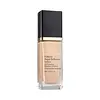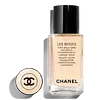What's inside
What's inside
 Key Ingredients
Key Ingredients

 Benefits
Benefits

 Concerns
Concerns

 Ingredients Side-by-side
Ingredients Side-by-side

Water
Skin ConditioningPhenyl Trimethicone
Skin ConditioningDimethicone
EmollientMethyl Trimethicone
Skin ConditioningButylene Glycol
HumectantEthylhexyl Methoxycinnamate
UV AbsorberPEG/PPG-18/18 Dimethicone
EmulsifyingCaprylic/Capric Triglyceride
MaskingIsocetyl Alcohol
EmollientPEG-10 Dimethicone
Skin ConditioningIsohexadecane
EmollientTitanium Dioxide
Cosmetic ColorantSorbitan Sesquioleate
EmulsifyingMagnesium Sulfate
Tribehenin
EmollientSodium Hyaluronate
HumectantHaberlea Rhodopensis Leaf Extract
Skin ConditioningBeta Vulgaris Root Extract
Skin ConditioningVaccinium Angustifolium Fruit Extract
Skin ProtectingVaccinium Macrocarpon Fruit Extract
AstringentNarcissus Extract
Ulmus Davidiana Root Extract
Skin ConditioningVaccinium Myrtillus Fruit Extract
Skin ConditioningYeast Extract
Skin ConditioningSimmondsia Chinensis Seed Oil
EmollientPalmitoyl Tripeptide-1
Skin ConditioningGlycerin
HumectantMethyldihydrojasmonate
MaskingTriethyl Citrate
MaskingMethicone
EmollientCholesterol
EmollientEthylhexyl Palmitate
EmollientEthylhexylglycerin
Skin ConditioningCaprylyl Glycol
EmollientSilica Dimethyl Silylate
EmollientPropylene Carbonate
SolventHydrogenated Lecithin
EmulsifyingAluminum Hydroxide
EmollientLaureth-7
EmulsifyingPolysilicone-11
Polymethylsilsesquioxane
Disteardimonium Hectorite
StabilisingLinoleic Acid
CleansingStearic Acid
CleansingSorbitan Stearate
EmulsifyingSorbitan Isostearate
EmulsifyingCalcium Chloride
AstringentSodium Sulfate
Magnesium Chloride
Potassium Nitrate
SoothingPotassium Phosphate
BufferingHydroxyacetophenone
AntioxidantTocopheryl Acetate
AntioxidantBHT
AntioxidantAscorbyl Palmitate
AntioxidantTocopherol
AntioxidantSodium Dehydroacetate
PreservativePhenoxyethanol
PreservativePotassium Sorbate
PreservativeCI 77491
Cosmetic ColorantCI 77492
Cosmetic ColorantCI 77499
Cosmetic ColorantWater, Phenyl Trimethicone, Dimethicone, Methyl Trimethicone, Butylene Glycol, Ethylhexyl Methoxycinnamate, PEG/PPG-18/18 Dimethicone, Caprylic/Capric Triglyceride, Isocetyl Alcohol, PEG-10 Dimethicone, Isohexadecane, Titanium Dioxide, Sorbitan Sesquioleate, Magnesium Sulfate, Tribehenin, Sodium Hyaluronate, Haberlea Rhodopensis Leaf Extract, Beta Vulgaris Root Extract, Vaccinium Angustifolium Fruit Extract, Vaccinium Macrocarpon Fruit Extract, Narcissus Extract, Ulmus Davidiana Root Extract, Vaccinium Myrtillus Fruit Extract, Yeast Extract, Simmondsia Chinensis Seed Oil, Palmitoyl Tripeptide-1, Glycerin, Methyldihydrojasmonate, Triethyl Citrate, Methicone, Cholesterol, Ethylhexyl Palmitate, Ethylhexylglycerin, Caprylyl Glycol, Silica Dimethyl Silylate, Propylene Carbonate, Hydrogenated Lecithin, Aluminum Hydroxide, Laureth-7, Polysilicone-11, Polymethylsilsesquioxane, Disteardimonium Hectorite, Linoleic Acid, Stearic Acid, Sorbitan Stearate, Sorbitan Isostearate, Calcium Chloride, Sodium Sulfate, Magnesium Chloride, Potassium Nitrate, Potassium Phosphate, Hydroxyacetophenone, Tocopheryl Acetate, BHT, Ascorbyl Palmitate, Tocopherol, Sodium Dehydroacetate, Phenoxyethanol, Potassium Sorbate, CI 77491, CI 77492, CI 77499
Water
Skin ConditioningDicaprylyl Carbonate
EmollientDimethicone
EmollientGlycerin
HumectantLauryl PEG-9 Polydimethylsiloxyethyl Dimethicone
Skin ConditioningSynthetic Fluorphlogopite
Isononyl Isononanoate
EmollientPentylene Glycol
Skin ConditioningPolymethylsilsesquioxane
Limnanthes Alba Seed Oil
Skin ConditioningTrimethylsiloxysilicate
EmollientKalanchoe Pinnata Leaf Extract
MaskingDimethicone/Vinyl Dimethicone Crosspolymer
Skin ConditioningStearalkonium Hectorite
Gel FormingParfum
MaskingDimethicone Crosspolymer
Emulsion StabilisingMagnesium Sulfate
Chlorphenesin
AntimicrobialCaprylyl Glycol
EmollientPropylene Carbonate
SolventAluminum Hydroxide
EmollientSodium Lauroyl Glutamate
Triethoxycaprylylsilane
Lysine
Skin ConditioningIsoceteth-10
EmulsifyingSilica
AbrasiveAlumina
AbrasiveMagnesium Chloride
Maltodextrin
AbsorbentTocopherol
AntioxidantCI 77491
Cosmetic ColorantCI 77492
Cosmetic ColorantCI 77499
Cosmetic ColorantCI 77891
Cosmetic ColorantWater, Dicaprylyl Carbonate, Dimethicone, Glycerin, Lauryl PEG-9 Polydimethylsiloxyethyl Dimethicone, Synthetic Fluorphlogopite, Isononyl Isononanoate, Pentylene Glycol, Polymethylsilsesquioxane, Limnanthes Alba Seed Oil, Trimethylsiloxysilicate, Kalanchoe Pinnata Leaf Extract, Dimethicone/Vinyl Dimethicone Crosspolymer, Stearalkonium Hectorite, Parfum, Dimethicone Crosspolymer, Magnesium Sulfate, Chlorphenesin, Caprylyl Glycol, Propylene Carbonate, Aluminum Hydroxide, Sodium Lauroyl Glutamate, Triethoxycaprylylsilane, Lysine, Isoceteth-10, Silica, Alumina, Magnesium Chloride, Maltodextrin, Tocopherol, CI 77491, CI 77492, CI 77499, CI 77891
 Reviews
Reviews

Ingredients Explained
These ingredients are found in both products.
Ingredients higher up in an ingredient list are typically present in a larger amount.
Aluminum Hydroxide is a form of aluminum. It can be naturally found in nature as the mineral gibbsite. In cosmetics, Aluminum Hydroxide is used as a colorant, pH adjuster, and absorbent.
As a colorant, Aluminum Hydroxide may add opacity, or reduce the transparency. Aluminum hydroxide is contains both basic and acidic properties.
According to manufacturers, this ingredient is an emollient and humectant. This means it helps hydrate the skin.
In medicine, this ingredient is used to help relieve heartburn and help heal ulcers.
There is currently no credible scientific evidence linking aluminum hydroxide in cosmetics to increased cancer risk.
Major health organizations allow the use of aluminum hydroxide in personal care products and have not flagged it as a carcinogenic risk at typical usage levels.
Learn more about Aluminum HydroxideCaprylyl Glycol is a humectant and emollient, meaning it attracts and preserves moisture.
It is a common ingredient in many products, especially those designed to hydrate skin. The primary benefits are retaining moisture, skin softening, and promoting a healthy skin barrier.
Though Caprylyl Glycol is an alcohol derived from fatty acids, it is not the kind that can dry out skin.
This ingredient is also used as a preservative to extend the life of products. It has slight antimicrobial properties.
Learn more about Caprylyl GlycolCi 77491 is also hydrated iron III oxide. It's sole purpose is to give a red/pink hue to products.
Iron III oxides are classified as inorganic chemicals for coloring.
Synthetically created Ci 77491 is considered safer than those naturally found. This is because the synthetically created version may contain less impurities. Iron oxides are generally non-toxic and non-allergenic.
Learn more about CI 77491Ci 77492 is also hydrated iron III oxide. It's sole purpose is to give a yellow hue to products.
Iron III oxides are classified as inorganic chemicals for coloring.
Synthetically created Ci 77492 is considered safer than those naturally found. This is because the synthetically created version may contain less impurities. Iron oxides are generally non-toxic and non-allergenic.
Learn more about CI 77492Ci 77499 is also hydrated iron III oxide. It is created from mixing red and black iron oxides. This helps give shades of darkness to a product.
Iron III oxides are classified as inorganic chemicals for coloring.
Dimethicone is a type of synthetic silicone created from natural materials such as quartz.
What it does:
Dimethicone comes in different viscosities:
Depending on the viscosity, dimethicone has different properties.
Ingredients lists don't always show which type is used, so we recommend reaching out to the brand if you have questions about the viscosity.
This ingredient is unlikely to cause irritation because it does not get absorbed into skin. However, people with silicone allergies should be careful about using this ingredient.
Note: Dimethicone may contribute to pilling. This is because it is not oil or water soluble, so pilling may occur when layered with products. When mixed with heavy oils in a formula, the outcome is also quite greasy.
Learn more about DimethiconeGlycerin is already naturally found in your skin. It helps moisturize and protect your skin.
A study from 2016 found glycerin to be more effective as a humectant than AHAs and hyaluronic acid.
As a humectant, it helps the skin stay hydrated by pulling moisture to your skin. The low molecular weight of glycerin allows it to pull moisture into the deeper layers of your skin.
Hydrated skin improves your skin barrier; Your skin barrier helps protect against irritants and bacteria.
Glycerin has also been found to have antimicrobial and antiviral properties. Due to these properties, glycerin is often used in wound and burn treatments.
In cosmetics, glycerin is usually derived from plants such as soybean or palm. However, it can also be sourced from animals, such as tallow or animal fat.
This ingredient is organic, colorless, odorless, and non-toxic.
Glycerin is the name for this ingredient in American English. British English uses Glycerol/Glycerine.
Learn more about GlycerinWe don't have a description for Magnesium Chloride yet.
Magnesium Sulfate is a salt. More specifically, it is an epsom salt, or the bath salt used to help relieve muscle aches.
Despite having ‘sulfate’ in the name, it isn’t a surfactant or cleansing agent like sodium lauryl sulfate. Unlike those sulfates, magnesium sulfate doesn’t have the same cleansing or foaming properties (it's simply a type of salt).
In cosmetics, Magnesium Sulfate is used to thicken a product or help dilute other solids. It is a non-reactive and non-irritating ingredient.
One study shows magnesium deficiency may lead to inflammation of the skin. Applying magnesium topically may help reduce inflammation.
You can find this ingredient in sea water or mineral deposits.
Learn more about Magnesium SulfatePolymethylsilsesquioxane is a silicone used as a film forming agent.
When applied to the skin, this ingredient creates an invisible film on the surface. This film still allows oxygen to pass through, but prevents moisture from escaping. This can help condition and hydrate the skin. It also leaves a silky feel when applied.
Polymethylsilsesquioxane has not been shown to clog pores. It has been deemed safe to use up to 55%, but most cosmetics use much less.
If you have concerns about using this ingredient, we recommend speaking with a professional.
Learn more about PolymethylsilsesquioxaneThis ingredient is a solvent. It helps dissolve active ingredients and alter the texture of products.
Propylene Carbonate is commonly used in makeup and with clay, such as montmorillonite or bentonite.
Studies show this ingredient to be safe for cosmetics. When it is undiluted, it can cause skin irritation. (It is always diluted in skincare and makeup). This ingredient is water-soluble.
Propylene Carbonate is created from propylene glycol and carbonic acid.
Learn more about Propylene CarbonateTocopherol (also known as Vitamin E) is a common antioxidant used to help protect the skin from free-radicals and strengthen the skin barrier. It's also fat soluble - this means our skin is great at absorbing it.
Vitamin E also helps keep your natural skin lipids healthy. Your lipid skin barrier naturally consists of lipids, ceramides, and fatty acids. Vitamin E offers extra protection for your skin’s lipid barrier, keeping your skin healthy and nourished.
Another benefit is a bit of UV protection. Vitamin E helps reduce the damage caused by UVB rays. (It should not replace your sunscreen). Combining it with Vitamin C can decrease sunburned cells and hyperpigmentation after UV exposure.
You might have noticed Vitamin E + C often paired together. This is because it is great at stabilizing Vitamin C. Using the two together helps increase the effectiveness of both ingredients.
There are often claims that Vitamin E can reduce/prevent scarring, but these claims haven't been confirmed by scientific research.
Learn more about TocopherolWater. It's the most common cosmetic ingredient of all. You'll usually see it at the top of ingredient lists, meaning that it makes up the largest part of the product.
So why is it so popular? Water most often acts as a solvent - this means that it helps dissolve other ingredients into the formulation.
You'll also recognize water as that liquid we all need to stay alive. If you see this, drink a glass of water. Stay hydrated!
Learn more about Water